CONNECT COOLER COMPRESSOR ASSEMBLY (w/ Air Conditioning System)
INSTALL ELECTRIC EGR CONTROL VALVE ASSEMBLY WITH NO. 2 EGR VALVE AND EGR COOLER (w/ EGR Cooler)
Water Pump (W/O Glow Plug Controller) -- Installation |
- NOTICE:
- When replacing the injectors (including shuffling the injectors between the cylinders), common rail or cylinder head, it is necessary to replace the injection pipes with new ones.
- When replacing the fuel supply pump, common rail, cylinder block, cylinder head, cylinder head gasket or timing gear case, it is necessary to replace the fuel inlet pipe with a new one.
- After removing the injection pipes, clean them with a brush and compressed air.
| 1. INSTALL ENGINE WATER PUMP ASSEMBLY |
Install a new gasket and the engine water pump with the 5 bolts and 2 nuts.
- Torque:
- 13 N*m{133 kgf*cm, 10 ft.*lbf}
| 2. INSTALL NO. 2 TIMING BELT COVER |
Apply seal packing (FIPG) to the specified areas shown in the illustration.
- Seal packing:
- Toyota Genuine Seal Packing Black, Three Bond 1207B or equivalent
Text in Illustration *1 Seal Packing - NOTICE:
- After applying FIPG, install the No. 2 timing belt cover within 3 minutes and tighten its bolts and nut within 15 minutes.
 |
Clean the bolts and their holes.
Apply adhesive to 2 or 3 threads at the end of each of the 4 bolts.
- Adhesive:
- Toyota Genuine Adhesive 1324, Three Bond 1324 or equivalent
Install the No. 2 timing belt cover with the 4 bolts and nut.
- Torque:
- 10 N*m{102 kgf*cm, 7 ft.*lbf}
| 3. INSTALL CAMSHAFT TIMING PULLEY |
Install the camshaft timing pulley.
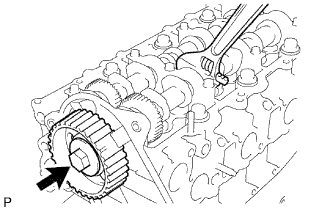 |
Tighten the bolt of the camshaft timing pulley while holding the camshaft with a wrench.
- Torque:
- 98 N*m{1000 kgf*cm, 72 ft.*lbf}
| 4. INSTALL NO. 1 TIMING BELT IDLER SUB-ASSEMBLY |
Using a 10 mm hexagon wrench, install a new washer and the No. 1 timing belt idler with the bolt.
- Torque:
- 35 N*m{357 kgf*cm, 26 ft.*lbf}
Check that the idler pulley moves smoothly.
If the idler pulley does not move smoothly, check the installation condition of the idler and washer.
| 5. INSTALL TIMING BELT |
Check that the timing marks are aligned as shown in the illustration.
Text in Illustration *1 Timing Mark - NOTICE:
- Make sure that the engine is cold.
- When turning the crankshaft, the valve heads will hit against the piston. Do not turn the crankshaft more than necessary.
- HINT:
- If reusing the timing belt, align the points marked during removal, and install the belt with the arrow pointing in the direction of crankshaft revolution.
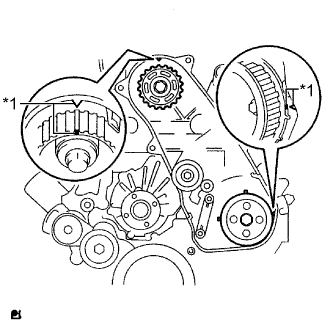 |
Install the timing belt to the pump drive shaft pulley, camshaft timing pulley and No. 1 timing belt idler in sequence.
Place the tensioner upright. Then set a press on the top of the tensioner.
- NOTICE:
- Do not scratch or deform the rod end.
- Press in the tensioner rod.
- Protect the tip of the push rod with a cloth in order to prevent damage.
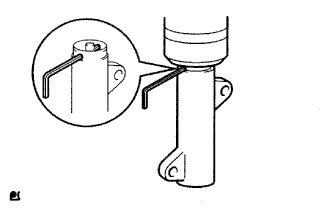 |
Using the press, slowly push in the push rod using 981 to 9800 N (100 to 999 kgf, 220 to 2203 lbf) of force.
- NOTICE:
- Do not apply a load of over 9800 N (999 kgf, 2203 lbf) to the push rod.
Align the holes of the push rod and housing. Then pass a 1.5 mm hexagon wrench through the holes to fix the push rod in place.
Temporarily install the timing belt tensioner with the 2 bolts while pushing the idler pulley toward the timing belt.
Tighten the 2 bolts.
- Torque:
- 13 N*m{133 kgf*cm, 10 ft.*lbf}
- NOTICE:
- Uniformly tighten the 2 bolts.
Remove the 1.5 mm hexagon wrench from the tensioner.
 |
Turn the crankshaft clockwise 720° and check that the timing marks are aligned as shown in the illustration.
Text in Illustration *1 Timing Mark
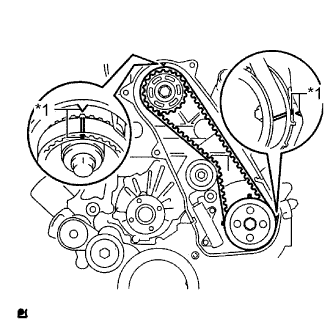 |
| 6. INSTALL NO. 1 TIMING BELT COVER |
Install the timing belt cover and 6 washers with the 6 bolts.
- Torque:
- 6.0 N*m{61 kgf*cm, 53 in.*lbf}
| 7. INSTALL CYLINDER HEAD COVER SUB-ASSEMBLY |
Install 4 new No. 3 cylinder head cover gaskets to the cylinder head cover in the directions shown in the illustration.
Text in Illustration *1 No. 3 Cylinder Head Cover Gasket *2 Cylinder Head Cover - NOTICE:
- Do not install the No. 3 cylinder head cover gaskets at an angle.
- Check that there is no foreign matter at the installation location of the No. 3 cylinder head cover gaskets.
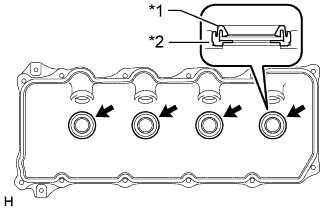 |
Remove any old seal packing (FIPG material) from the cylinder head.
Apply seal packing to the specific areas shown in the illustration.
- Seal packing:
- Toyota Genuine Seal Packing Black, Three Bond 1207B or equivalent
Text in Illustration 
Seal Packing - NOTICE:
- Remove any oil from the contact surface.
- Install the head cover within 3 minutes after applying seal packing.
- Do not start the engine for at least 2 hours after installing the seal packing.
 |
Install a new cylinder head cover gasket and the cylinder head cover with the 10 bolts and 2 nuts.
- Torque:
- 9.0 N*m{92 kgf*cm, 80 in.*lbf}
Install 4 new nozzle holder seals.
Connect the ventilation hose.
Connect the 4 connectors and install the 3 bolts.
- Torque:
- 13 N*m{127 kgf*cm, 9 ft.*lbf}
| 8. INSTALL NO. 4 INJECTION PIPE SUB-ASSEMBLY |
- NOTICE:
- When replacing an injector, it is necessary to replace the 4 injection pipes with new ones.
- Keep the joints of the injection pipe clean.
Temporarily install the No. 4 injection pipe with the union nuts.
w/ EGR Cooler:
Install the bolt.- Torque:
- 5.0 N*m{51 kgf*cm, 44 in.*lbf}
- NOTICE:
- If an injection pipe clamp is removed from the No. 4 injection pipe, replace the injection pipe clamp with a new one.
- Make sure that the inner rubbers of the injection pipe fit inside the clamps.
- When installing the pipe, check that the inner rubbers and the clamps are in their proper positions.
w/o EGR Cooler:
Install the 2 bolts.- Torque:
- 13 N*m{130 kgf*cm, 9 ft.*lbf}
- NOTICE:
- If an injection pipe clamp is removed from the No. 4 injection pipe, replace the injection pipe clamp with a new one.
- Make sure that the inner rubbers of the injection pipe fit inside the clamps.
- When installing the pipe, check that the inner rubbers and the clamps are in their proper positions.
Using a 17 mm union nut wrench, tighten the injection pipe union nuts on the common rail side.
- Torque:
- 35 N*m{357 kgf*cm, 26 ft.*lbf}
- NOTICE:
- Use the formula to calculate special torque values for situations where a union nut wrench is combined with a torque wrench (HILUX_TGN26 RM000004QR1006X.html).
Using a union nut wrench, tighten the injection pipe union nuts on the injector side.
- Torque:
- 35 N*m{357 kgf*cm, 26 ft.*lbf}
- NOTICE:
- Use the formula to calculate special torque values for situations where a union nut wrench is combined with a torque wrench (HILUX_TGN26 RM000004QR1006X.html).
| 9. INSTALL NO. 1, NO. 2 AND NO. 3 INJECTION PIPE SUB-ASSEMBLY |
- NOTICE:
- When replacing an injector, it is necessary to replace the 4 injection pipes with new ones.
- Keep the joints of the injection pipes clean.
Temporarily install the No. 1, No. 2 and No. 3 injection pipes with the union nuts.
w/ EGR Cooler:
Install the No. 2 and No. 3 injection pipe clamps with the 2 bolts and 2 nuts as shown in the illustration.- Torque:
- 5.0 N*m{51 kgf*cm, 44 in.*lbf}
Text in Illustration *1 No. 2 Injection Pipe *2 No. 2 Injection Pipe Clamp *3 No. 3 Injection Pipe Clamp *4 Painted Mark - HINT:
- If the painted mark on the No. 2 injection pipe has disappeared, use the illustration as a reference to install the clamps.
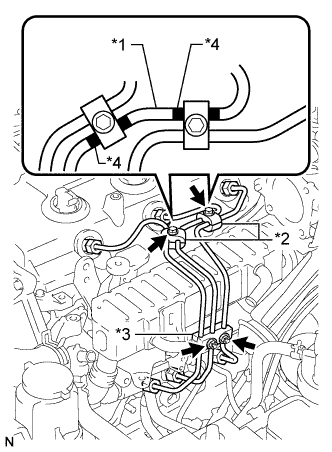 |
w/o EGR Cooler:
Install the No. 2 and No. 3 injection pipe clamps with the bolt and 2 nuts as shown in the illustration.- Torque:
- 5.0 N*m{51 kgf*cm, 44 in.*lbf}
Text in Illustration *1 No. 1 Injection Pipe *2 No. 2 Injection Pipe Clamp *3 No. 3 Injection Pipe Clamp *4 Painted Mark - HINT:
- If the painted mark on the No. 1 injection pipe has disappeared, use the illustration as a reference to install the clamps.
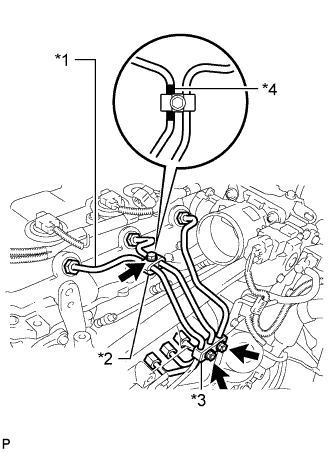 |
Using a 17 mm union nut wrench, tighten the injection pipe union nuts on the common rail side.
- Torque:
- 35 N*m{357 kgf*cm, 26 ft.*lbf}
- NOTICE:
- Use the formula to calculate special torque values for situations where a union nut wrench is combined with a torque wrench (HILUX_TGN26 RM000004QR1006X.html).
Using a 17 mm union nut wrench, tighten the injection pipe union nuts on the injector side.
- Torque:
- 35 N*m{357 kgf*cm, 26 ft.*lbf}
- NOTICE:
- Use the formula to calculate special torque values for situations where a union nut wrench is combined with a torque wrench (HILUX_TGN26 RM000004QR1006X.html).
| 10. INSTALL V-RIBBED BELT TENSIONER ASSEMBLY |
Install the V-ribbed belt tensioner with the 4 bolts.
- Torque:
- 21 N*m{214 kgf*cm, 15 ft.*lbf}
Text in Illustration *1 Cylinder Block *2 V-ribbed Belt Tensioner - HINT:
- Firmly press and hold the V-ribbed belt tensioner against the cylinder block to eliminate any gaps in the areas labeled A in the illustration. Then uniformly tighten the 4 bolts.
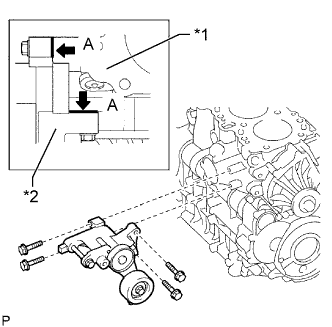 |
| 11. INSTALL GENERATOR BRACKET |
Install the generator bracket with the bolt.
- Torque:
- 25 N*m{255 kgf*cm, 18 ft.*lbf}
| 12. INSTALL GENERATOR ASSEMBLY |
 |
Install the generator with the 2 bolts.
- Torque:
- for bolt A:
- 62 N*m{632 kgf*cm, 46 ft.*lbf}
- for bolt B:
- 25 N*m{255 kgf*cm, 18 ft.*lbf}
Install the generator wire with the nut.
- Torque:
- 9.8 N*m{100 kgf*cm, 87 in.*lbf}
Connect the generator connector.
| 13. INSTALL NO. 2 IDLE PULLEY ASSEMBLY |
Install the spacer, No. 2 idle pulley and pulley plate with the bolt.
- Torque:
- 45 N*m{459 kgf*cm, 33 ft.*lbf}
| 14. CONNECT COOLER COMPRESSOR ASSEMBLY (w/ Air Conditioning System) |
Connect the cooler compressor with the 4 bolts.
- Torque:
- 25 N*m{250 kgf*cm, 18 ft.*lbf}
| 15. INSTALL FAN SHROUD |
Install the fan pulley to the engine water pump.
Install the fan shroud together with the fluid coupling with fan between the radiator and engine component.
- NOTICE:
- Be careful not to damage the radiator core.
Install the fluid coupling with fan to the fan pulley with the 4 nuts.
Tighten the nuts as much as possible by hand.
Attach the claws of the fan shroud to the radiator.
 |
Install the fan shroud with the 2 bolts.
- Torque:
- 5.0 N*m{51 kgf*cm, 44 in.*lbf}
Install the fan and generator V belt (HILUX_TGN26 RM000001474015X.html).
Tighten the 4 nuts of the fluid coupling with fan.
- Torque:
- 23 N*m{235 kgf*cm, 17 ft.*lbf}
Install the radiator reservoir with the 2 bolts.
- Torque:
- 5.0 N*m{51 kgf*cm, 44 in.*lbf}
Connect the No. 1 and No. 2 water by-pass hoses to the radiator.
Install the oil reservoir with the 3 bolts.
- Torque:
- 4.5 N*m{46 kgf*cm, 40 in.*lbf}
| 16. INSTALL RADIATOR HOSE INLET |
| 17. INSTALL ELECTRIC EGR CONTROL VALVE ASSEMBLY WITH NO. 2 EGR VALVE AND EGR COOLER (w/ EGR Cooler) |
| 18. INSTALL INTERCOOLER ASSEMBLY |
| 19. CONNECT CABLE TO NEGATIVE BATTERY TERMINAL |
- NOTICE:
- When disconnecting the cable, some systems need to be initialized after the cable is reconnected (HILUX_TGN26 RM000004QR300CX.html).
| 20. BLEED AIR FROM FUEL SYSTEM |
Using the hand pump mounted on the fuel filter cap, bleed the air from the fuel system. Continue pumping until the pump resistance increases.
- NOTICE:
- Hand pump pumping speed: Max. 2 strokes/ sec.
- The hand pump must be pushed with a full stroke during pumping.
- When the fuel pressure at the supply pump inlet port reaches a saturated pressure, the hand pump resistance increases.
- If pumping is interrupted during the air bleeding process, fuel in the fuel line may return to the fuel tank. Continue pumping until the hand pump resistance increases.
- If the hand pump resistance does not increase despite consecutively pumping 200 times or more, there may be a fuel leak between the fuel tank and fuel filter, the hand pump may be malfunctioning, or the vehicle may have run out of fuel.
- If air bleeding using the hand pump is incomplete, the common rail pressure does not rise to the pressure range necessary for normal use, and the engine cannot be started.
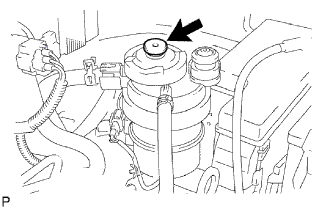 |
Check if the engine starts.
- NOTICE:
- Even if air bleeding using the hand pump has been completed, the starter may need to be cranked for 10 seconds or more to start the engine.
- Do not crank the engine continuously for more than 20 seconds. The battery may be discharged.
- Use a fully-charged battery.
When the engine can be started, proceed to the next step.
If the engine cannot be started, bleed the air again using the hand pump until the hand pump resistance increases (refer to the procedures above). Then start the engine.
Turn the ignition switch off.
Connect the intelligent tester to the DLC3.
Turn the ignition switch to ON and turn the intelligent tester on.
Clear the DTCs.
- w/ EGR Cooler: (HILUX_TGN26 RM000000PDK0SYX.html)
- w/o EGR Cooler: (HILUX_TGN26 RM000000PDK0T9X.html)
- w/ EGR Cooler: (HILUX_TGN26 RM000000PDK0SYX.html)
Start the engine.*1
Enter the following menus: Powertrain / Engine and ECT / Active Test / Test the Fuel Leak.*2
Text in Illustration *a Reference
(Active Test Operation)
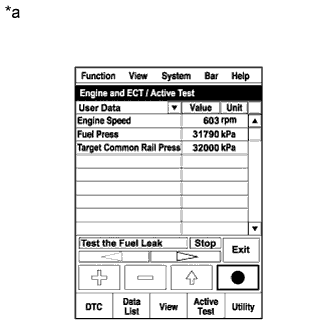 |
Perform the following test 5 times with on/off intervals of 10 seconds: Active Test / Test the Fuel Leak.*3
Allow the engine to idle for 3 minutes or more after performing the Active Test for the fifth time.
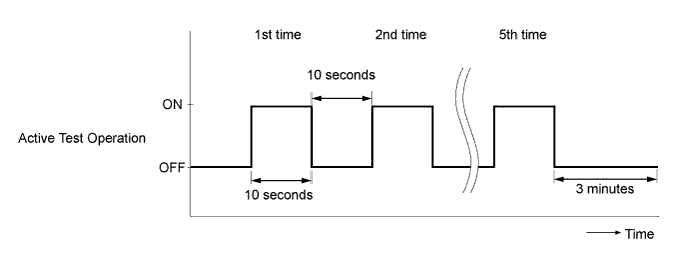
- HINT:
- When the Active Test "Test the Fuel Leak" is used to change the pump control mode, the actual fuel pressure inside the common rail drops below the target fuel pressure when the Active Test is off, but this is normal and does not indicate a pump malfunction.
Enter the following menus: Powertrain / Engine and ECT / DTC.
Read Current DTCs.
Clear the DTCs.
- w/ EGR Cooler: (HILUX_TGN26 RM000000PDK0SYX.html)
- w/o EGR Cooler: (HILUX_TGN26 RM000000PDK0T9X.html)
- HINT:
- It is necessary to clear the DTCs, as DTC P1604 or P1605 may be stored when air is bled from the fuel system after replacing or repairing fuel system parts.
- w/ EGR Cooler: (HILUX_TGN26 RM000000PDK0SYX.html)
Repeat steps *1 to *3.
Enter the following menus: Powertrain / Engine and ECT / DTC.
Read Current DTCs.
- OK:
- No DTCs are output.
| 21. ADD ENGINE COOLANT |
Tighten the radiator drain cock plug by hand.
Tighten the cylinder block drain cock plug.
- Torque:
- 8.0 N*m{82 kgf*cm, 71 in.*lbf}
Fill the radiator with TOYOTA Super Long Life Coolant (SLLC) to the B line of the radiator reservoir.
- Standard Capacity:
Item Specified Condition for Automatic Transmission 11.1 liters (11.7 US qts, 9.8 Imp. qts) for Manual Transmission 9.8 liters (10.4 US qts, 8.6 Imp. qts)
- NOTICE:
- Never use water as a substitute for engine coolant.
- HINT:
- TOYOTA vehicles are filled with TOYOTA SLLC at the factory. In order to avoid damage to the engine cooling system and other technical problems, only use TOYOTA SLLC or similar high quality ethylene glycol based non-silicate, non-amine, non-nitrite, non-borate coolant with long-life hybrid organic acid technology (coolant with long-life hybrid organic acid technology consists of a combination of low phosphates and organic acids).
- Please contact your TOYOTA dealer for further details.
Press the inlet and outlet radiator hoses several times by hand, and then check the level of the coolant.
If the coolant level drops below the B line, add TOYOTA SLLC to the B line.
Install the radiator reservoir cap.
Using a wrench, install the vent plug.
- Torque:
- 2.0 N*m{20 kgf*cm, 17 in.*lbf}
Bleed air from the cooling system.
Warm up the engine until the thermostat opens. While the thermostat is open, circulate the coolant for several minutes.
Maintain the engine speed at 2500 to 3000 rpm.
Press the inlet and outlet radiator hoses several times by hand to bleed air.
- CAUTION:
- When pressing the radiator hoses:
- Wear protective gloves.
- Be careful as the radiator hoses are hot.
- Keep your hands away from the radiator fan.
Stop the engine and wait until the coolant cools down to ambient temperature.
- CAUTION:
- Do not remove the radiator reservoir cap while the engine and radiator are still hot. Pressurized, hot engine coolant and steam may be released and cause serious burns.
After the coolant cools down, check that the coolant level is at the F line.
If the coolant level is below the F line, add TOYOTA SLLC to the F line.
| 22. INSPECT FOR COOLANT LEAK |
- CAUTION:
- Do not remove the radiator reservoir cap while the engine and radiator are still hot. Pressurized, hot engine coolant and steam may be released and cause serious burns.
- NOTICE:
- Before each inspection, turn the A/C switch off.
Fill the radiator with coolant and attach a radiator cap tester.
Warm up the engine.
Using the radiator cap tester, increase the pressure inside the radiator to 118 kPa (1.2 kgf/cm2, 17 psi), and check that the pressure does not drop.
If the pressure drops, check the hoses, radiator and water pump for leaks. If no external leaks are found, check the heater core, cylinder block and head.
| 23. INSPECT FOR FUEL LEAK |
- CAUTION:
- During Active Test mode, the engine speed becomes high and the combustion noise becomes loud, so pay attention.
- During Active Test mode, the fuel pressure becomes high. Be extremely careful not to expose your eyes, hands, or body to escaping fuel.
Check that there are no leaks from any part of the fuel system when the engine is stopped. If there is fuel leakage, repair or replace parts as necessary.
Start the engine and check that there are no leaks from any part of the fuel system. If there is fuel leakage, repair or replace parts as necessary.
Disconnect the return hose from the common rail.
Start the engine and check for fuel leaks from the return pipe.
If there is fuel leakage, replace the common rail.
Connect the intelligent tester to the DLC3.
Start the engine and push the intelligent tester main switch on.
Select the Fuel Leak test from the Active Test mode on the intelligent tester.
If the intelligent tester is not available, fully depress the accelerator pedal quickly. Increase the engine speed to the maximum and maintain that speed for 2 seconds. Repeat this operation several times.
Check that there are no leaks from any part of the fuel system.
- NOTICE:
- A return pipe leakage of less than 10 cc (0.6 cu in.) per minute is acceptable.
Reconnect the return hose to the common rail.
| 24. INSPECT FOR OIL LEAK |
Start the engine. Make sure that there are no oil leaks from the areas that were worked on.
| 25. INSTALL NO. 1 ENGINE UNDER COVER |
- Torque:
- 28 N*m{286 kgf*cm, 21 ft.*lbf}